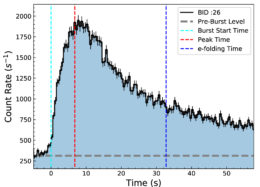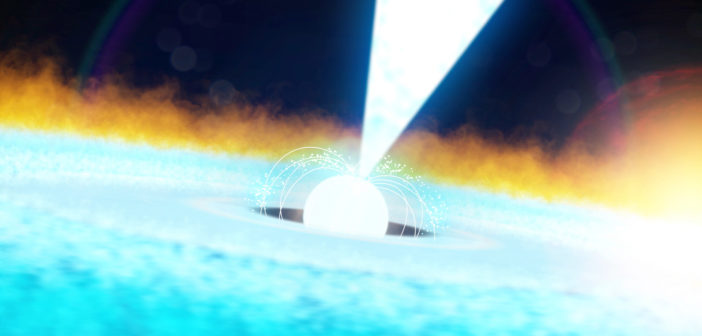When a neutron star snares material from a stellar companion, we see a flash of X-rays called an X-ray burst. What can an analysis of 51 bursts from a single source tell us about the physics behind these events?
Bursting Binary Systems

A view of the Neutron star Interior Composition Explorer (NICER), seen at the center of this image, in its berth on the International Space Station. [NASA]
One of our best tools for studying these bursts is the Neutron star Interior Composition Explorer (NICER), which has monitored X-rays from its vantage point on the International Space Station since 2017. Among NICER’s many targets is the highly active binary 4U 1636–536, which was discovered just over 50 years ago. Researchers have cataloged hundreds of X-ray bursts from 4U 1636–536, finding that it averages one burst every four hours!

An example of an X-ray burst from 4U 1636–536 as seen by NICER. [Adapted from Güver et al. 2022]
Accretion Increases and Disk Reflections
In a recent publication, a team led by Tolga Güver (Istanbul University) searched for evidence of additional X-ray bursts from 4U 1636–536 during a monitoring campaign with NICER. Güver and collaborators identified 51 X-ray bursts during 138 observations and collected spectra for 40 of them, allowing the team to characterize 4U 1636–536’s bursting behavior and understand how X-ray bursts affect their surroundings.
Güver and collaborators found that all of the bursts for which they acquired spectra had an excess of soft (i.e., low-energy) X-ray emission. Modeling of this spectral feature indicated that it likely arises from either an increase in the rate at which matter is accreted onto the neutron star or from the burst scattering off the disk and/or being absorbed and re-emitted at a different wavelength, a process referred to as reflection. However, many of the bursts were fit well by models of both scenarios, and the authors pointed out that both processes likely occur simultaneously.
Further X-ray Investigations
To learn even more about 4U 1636–536’s frequent outbursts, Güver and collaborators analyzed data from India’s multi-wavelength space telescope AstroSat and the Nuclear Spectroscopic Telescope Array (NuSTAR). Using NuSTAR data, the team searched for evidence of Compton cooling, in which high-energy photons lose some of their energy through collisions with nearby electrons. The team discovered decreases in the hard (i.e., high-energy) X-ray emission shortly after the onset of several bursts, but the low count rate prevented a firm detection.

Comparison of reduced χ2 values for best fits to the NICER spectra using the disk reflection model (blue) and the increased accretion model (red). [Güver et al. 2022]
Citation
“Burst–Disk Interaction in 4U 1636–536 as Observed by NICER,” Tolga Güver et al 2022 ApJ 935 154. doi:10.3847/1538-4357/ac8106

